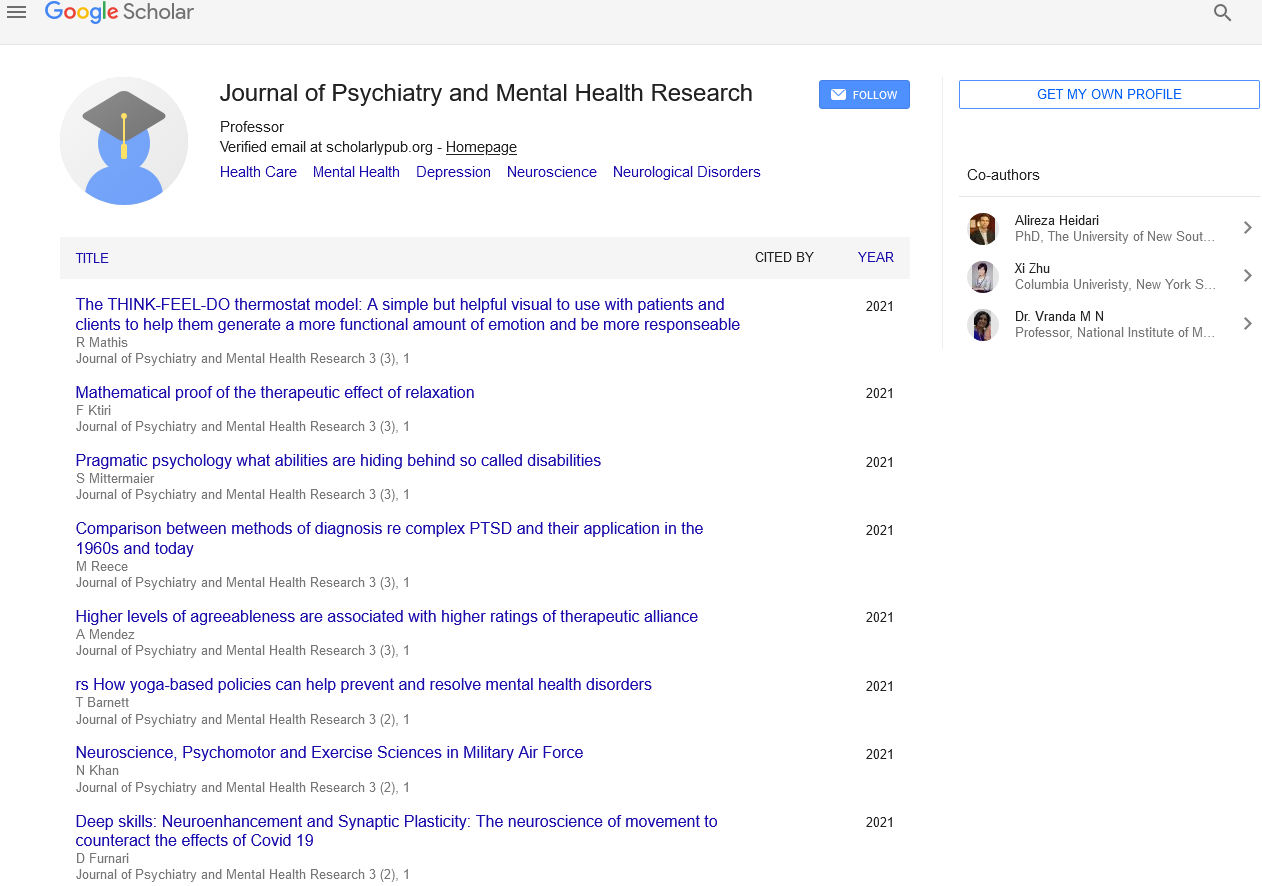Alzheimer as an autoimmune disease
Received: 05-Apr-2022, Manuscript No. PULPMHR-22-4622; Editor assigned: 06-Apr-2022, Pre QC No. PULPMHR-22-4622(QC); Accepted Date: Apr 16, 2022; Reviewed: 10-Apr-2022 QC No. PULPMHR-22-4622(Q); Revised: 15-Apr-2022, Manuscript No. PULPMHR-22-4622(R); Published: 17-Apr-2022
This open-access article is distributed under the terms of the Creative Commons Attribution Non-Commercial License (CC BY-NC) (http://creativecommons.org/licenses/by-nc/4.0/), which permits reuse, distribution and reproduction of the article, provided that the original work is properly cited and the reuse is restricted to noncommercial purposes. For commercial reuse, contact reprints@pulsus.com
Abstract
Throughout the course of recent many years, alzheimer's sickness, once thought to be an uncommon turmoil, has risen up out of lack of clarity to turn into a significant public medical condition. In view of an absence of treatment, it has been by and large considered as an irreversible, moderate mind infection that gradually annihilates memory and figuring abilities, in the long run even the capacity to co- -mplete the least complex errands. It is a constant neurodegenerative issue of inadequately (or not) comprehended causes. In view of distinguished risk factors, a few speculations theories have been propounded for its causes past hereditary qualities: cholinergic, amyloid-β, tau, viral or parasitic disease, neurovascular, neuroinflammation, neurodevelopmental, cardiovascular, gum illness contamination, brokenness of oligodendrocytes, others connected with way of life, diet, and the climate, and numerous others.
Keywords
Alzheimer; Autoimmune; Neuroethology
Introduction
Such a wide exhibit of speculations is without help from anyone else characteristic of our absence of genuine arrangement and information on the infection in any case the way that it has been distinguished and portrayed beginning around 1901, and been the subject of an extensive number of distributions managing it (more than 50,000, as indicated by certain creators). Further, one must remember that hazard isn't causation and chance administration isn't treatment just mitigation. Regardless of cases by some examination clinicians, there are at present no known medicines if by some stroke of good luck to stop or converse the movement of the illness. A portion of these supposed medicines, including the supported program DESS (Diet, Exercise, Stress, Sleep, and minor departure from this topic) are palliative in nature, briefly improving symptoms, while the infection advances unabated. Research has rather engaged on diagnosing the condition before side effects start. In this way, a number of biochemical tests have been created to endeavor before discovery counting investigation of the cerebrospinal liquid for amyloid-beta (Aβ) or tau proteins and preventive counter acting agent immunization. Neuroprotective specialists, (for example, for models, Al-108, PBT2 and TNFα receptor blocking combination protein etarnacept) have additionally been planned. Further, among the in excess of 400 drug medicines having been examined or in cutting edge clinical preliminaries, putative drug treatments endeavor to treat the fundamental illness pathology such as by decrease of Aβ levels (e.g., by apo morphine, investigational immunotherapy, or immunization) and restraining tau accumulation (e.g. With methylthionium chloride and dimebon).
Background
Once more, but supportive such medicines are not corrective. Then again other softer philosophies include contemplation and against parasitic contamination of the mind. In a nutshell, while palliative medicines are accessible, neurodegenerative problems as a general rule, and alzheimer's specifically, have commonly been proclaimed as serious. The explanation is that we have not yet had the option to distinguish the etiology and profound science of their root cause(s). In this article, the main driver is the cerebrum's immune system framework having denounced any kind of authority in its ineffective endeavors to keep up with cerebrum homeostasis between the hostile synaptoblastic and synaptoclastic pressures. The fix would then legitimately be to adjust these tensions by managing the framework as opposed to savagely fighting either the hyper excited synaptoblastic pressures or/and smothering the synaptoclastic ones. Putative immunological treatments, in light of the idea of preparing the invulnerable framework to perceive, assault, and converse the affidavit of Aβ have been planned. Tragically, such a proxy end-point has not been clinically exhibited to fix the infection, i.e., even after the amyloid plaques had been taken out, the sickness side effects persevered and the actual sickness proceeded with its pernicious advancement. Moreover, immunotherapeutic specialists have been found to cause some disturbing antagonistic medication responses. Even further, one significant impediment of dynamic and uninvolved immunotherapy, as presently rehearsed, is the low measure of antibodies that can pass the blood-cerebrum obstruction (this may, nonetheless, be overwhelmed by coupling antibodies to the peptide penetration). Conversely, and in differentiation with the antibodies utilized, a few little particles have been intended to promptly pass the boundary while conveying helpful mixtures at the right areas in the right measurements sums, proclaiming another treatment approach. This is additionally what nano medicine and nanotechnology vow to do. No withstanding, while the innovation is presently notable, its application to neurodegenerative problems, including alzheimer's, has not yet been attempted. Learn further about the abecedarian systems that control the neurological framework and, thusly, monster geste.
Conclusion
The present circumstance is suggestive of that for different sicknesses, especially malignant growth. It was only after we arrived at the place of understanding that harmful cells like solid cells from which they develop are plaited in our genome, and that malignant growth isn't an organ infection however the consequence of numerous hereditarychanges, i.e., understanding the profound science of malignant growth, that we have taken extraordinary steps in disease treatment and fix.Witness the rise of immuno-oncology and the new U.S. FDAendorsed utilization of fanciful antigen receptor (CAR) T-cells. Immunotherapy has been effective in initiating long haul reductions of difficult to treat tumors. The early distinguished protein receptor on the outer layer of T-cells (cytotoxic T-lymphocyte antigen 4, CTL-4) and a particle (customized demise 1, PD-1) prompted shocking cancer shrinkage and expanded endurance, especially in metastatic melanoma.
Consequently, against CTL-4 and hostile to PD-1 has opened up new vistas in growth treatment. Past that, hereditarily changed patient's Tcells and PD-1 particles vow to be significantly more viable in customized medication.





